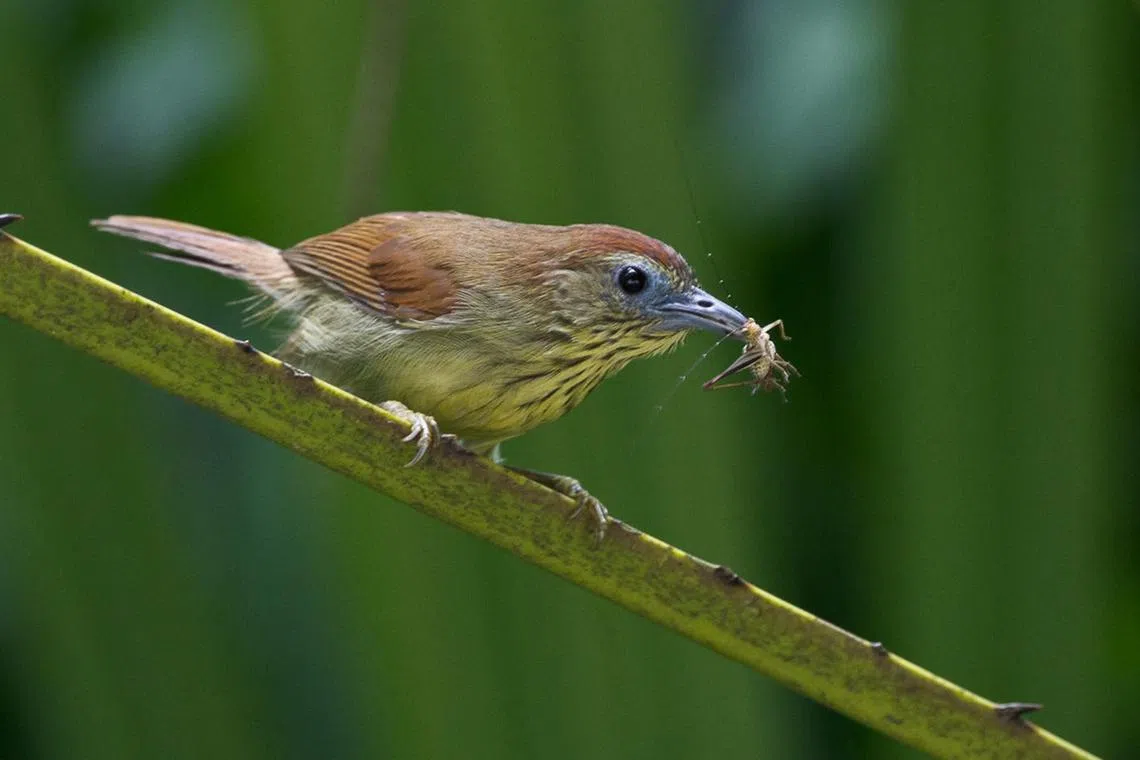Presence of water bodies encourages bird diversity in urban green spaces: NParks study
Sign up now: Get ST's newsletters delivered to your inbox

The pin-striped tit-babbler is among certain species of birds found to prefer more irregularly shaped urban green spaces.
PHOTO: FRANCIS YAP
Follow topic:
SINGAPORE - The presence of water bodies such as ponds and semi-natural habitat – including grasslands and younger secondary forests – are among the factors that encourage bird diversity in urban green spaces in Singapore, according to a National Parks Board (NParks) study.
The study also found that regularly shaped green spaces, such as circles or squares, had higher bird diversity.
Such spaces have a larger core and fewer edge habitats – referring to the boundary between two land cover types, such as a forest and open grassland – which are associated with greater human disturbance and fewer resources for nesting.
These findings will guide the planning and design of urban green spaces in Singapore, NParks said on Thursday.
The study analysed data collected between 2015 and 2019 by over 1,100 “citizen scientists”, who are members of the public, under NParks’ Garden Bird Watch initiative to study factors influencing bird diversity here.
Volunteers for the watch undergo training on basic survey and birdwatching techniques, before being assigned to survey birds at a particular site.
The study recorded almost 70,000 sightings of 184 bird species from 64 sites across the island, including urban parks and nature parks, and the findings were published in the academic journal Landscape and Urban Planning in March 2023.
While the study found greater bird diversity in regularly shaped green urban spaces, it noted, however, that certain species of birds preferred more irregularly shaped urban green spaces as they had adapted to edge habitats.
These include the dark-necked tailorbird, which has an olive upper and black streaks on its upper breast, and the pin-striped tit-babbler, with its prominent dark streaks on the throat and upper breast.
Water bodies within and around urban green spaces also increased the variety of birds observed, the study found.
Carnivores such as egrets and kingfishers are commonly found around freshwater bodies as they depend on fish as a source of food.
Swallows can also be found at such freshwater bodies, where they can hunt for insects.
“The findings from this study will help urban planners and landscape architects plan and design future parks which are conducive not just to park users, but to our biodiversity as well,” NParks said.
To enhance local bird diversity, urban planners should consider setting aside a regularly shaped parcel of land – rather than an elongated or irregularly shaped plot – for an urban green space, the study said, adding that including “semi-natural vegetation” and water bodies will also help sustain more bird species in such spaces.
“These findings demonstrate the key role of the community in contributing towards the conservation of Singapore’s natural heritage,” NParks said.
The Garden Bird Watch, which has been held annually since 2015, is part of NParks’ Community in Nature Biodiversity Watch series.
NParks noted that the number of citizen scientists who have participated in its Community in Nature initiatives has grown from less than 500 in 2015 to more than 11,000 in 2022.
Members of the public interested in participating in the Garden Bird Watch or supporting conservation efforts can find out more at the Festival of Biodiversity, which will be held on Saturday and Sunday at integrated community hub Heartbeat@Bedok.
The festival will also see the launch of a new book, Guide to Macrofungi of Singapore. Produced by NParks and the National University of Singapore, the book identifies more than 160 species of macrofungi, such as mushrooms, found here.

